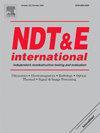水泥基介质非均质性表征的弹性波色散
IF 4.1
2区 材料科学
Q1 MATERIALS SCIENCE, CHARACTERIZATION & TESTING
引用次数: 0
摘要
超声已被广泛用于监测胶凝材料和结构的结构状况。波速和其他参数携带有价值的信息,因为它取决于材料的刚度和非均质性。虽然它被用于对性能的初步估计,但尚未达到全面的检查能力,特别是现场检查能力。特别是,即使测量到低于预期的波速,它们也不能直接归因于特定的恶化机制或非均质性大小。原因包括脉冲速度对早期损伤迹象的灵敏度有限,根据结构状况解释波形的能力有限,以及包括声耦合在内的技术问题。本文表明,适当的超声弥散解释可以为可靠地评估典型的空洞尺寸铺平道路,允许基于工程标准的维护决策,而不是建立但粗略的脉冲速度与混凝土质量的经验相关性。强调了理论研究在解释实验获得的行为方面的贡献。由于波长与非均匀性或典型空洞尺寸之间的相互作用,应用频率的重要性是至关重要的。本文章由计算机程序翻译,如有差异,请以英文原文为准。
Elastic wave dispersion for heterogeneity characterization in cement-based media
Ultrasound has been extensively used to monitor the structural condition of cementitious materials and structures. Wave velocity among other parameters carries valuable information, as it depends on the material stiffness and heterogeneity. Although it is used for a first estimate of the performance, still, the full inspection capacity, especially in-situ has not been reached. Specifically, even when lower-than-expected wave velocities are measured, they cannot be attributed directly to a specific deterioration mechanism or heterogeneity size. Reasons include the limited sensitivity of pulse velocity to early signs of damage, limited capacity to interpret the waveform in terms of the structural condition, as well as technical issues including acoustic coupling. The present paper demonstrates that proper ultrasonic dispersion interpretation can pave the way to reliable assessment of the typical void size, allowing maintenance decisions based on engineering criteria in addition to established but rough empirical correlations of pulse velocity to concrete quality. The contribution of theoretical investigations in the explanation of the experimentally obtained behaviour is highlighted. The importance of the applied frequency is paramount because of the interaction between the wavelength and the heterogeneity or typical void size.
求助全文
通过发布文献求助,成功后即可免费获取论文全文。
去求助
来源期刊

Ndt & E International
工程技术-材料科学:表征与测试
CiteScore
7.20
自引率
9.50%
发文量
121
审稿时长
55 days
期刊介绍:
NDT&E international publishes peer-reviewed results of original research and development in all categories of the fields of nondestructive testing and evaluation including ultrasonics, electromagnetics, radiography, optical and thermal methods. In addition to traditional NDE topics, the emerging technology area of inspection of civil structures and materials is also emphasized. The journal publishes original papers on research and development of new inspection techniques and methods, as well as on novel and innovative applications of established methods. Papers on NDE sensors and their applications both for inspection and process control, as well as papers describing novel NDE systems for structural health monitoring and their performance in industrial settings are also considered. Other regular features include international news, new equipment and a calendar of forthcoming worldwide meetings. This journal is listed in Current Contents.
 求助内容:
求助内容: 应助结果提醒方式:
应助结果提醒方式:


